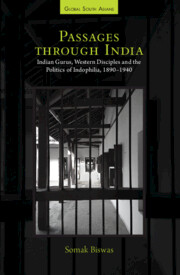2 - Home in the World: Indophiles and the Ashram
Published online by Cambridge University Press: 30 June 2023
Summary
The modern ashram in India came to encapsulate a new kind of utopian community where alternative modes of living were imagined and put to practice. This chapter examines why Western disciples sought wilful participation in these aspirational worlds to territorialise their Indophilia. Ashrams acted as emotional communities with a set of practices and performances that mobilised the affections of Indophile followers around given spaces.
Prologue
Ashrams constituted a major preoccupation for both gurus and disciples. Tagore, Gandhi and Vivekananda instituted major ashram experiments from within, but not exclusively, a Hindu tradition. Only the former two lived long enough to see them grow into definite institutions. Shantiniketan and Sabarmati emerged as the loci of intense striving for their disciples. From 1913 onwards till their deaths, Pearson, Andrews and Mira actively inhabited and invested in their mentors’ ashrams. Ashrams figured constantly in their letters, reinforcing ashramic and epistolary practice as sites of intimate self-making. Ashram engagements determined disciples’ Indophilia.
The historian Barbara Rosenwein defines emotional communities as ‘groups in which people adhere to the same norms of emotional expression and value – or devalue – the same or related emotions’. Disciples’ complex emotional responses in trying to relate to their gurus’ ashrams produced a range of practices. Ashrams became spaces to rethink their own cultural and political subjectivities while making them available for anticolonial projects outside of the ashram, as shown in the subsequent chapter on indenture.
Andrews, Pearson and Mira's coming to these ashrams represented a coming closer to their mentors’ worlds. All of them were drawn and captivated by the utopian communities built and fostered by their mentors. However, the senses of this captivation worked differently. Pearson and Andrews wanted to be ‘captive’ to the promise of freedom that Shantiniketan enjoined, with its unstructured method of life and education; Mira, on the other hand, sought to enter a tightly wound institution of strict discipline and control, and make herself a pliant subject for the ashram and Gandhi to mould. The difference in the emphases of Gandhi and Tagore's ashrams was reflected in their disciples’ experiences.
- Type
- Chapter
- Information
- Passages through IndiaIndian Gurus, Western Disciples and the Politics of Indophilia, 1890–1940, pp. 57 - 116Publisher: Cambridge University PressPrint publication year: 2023



